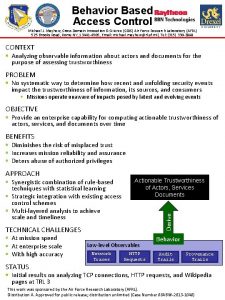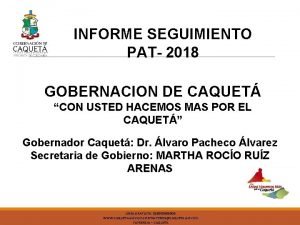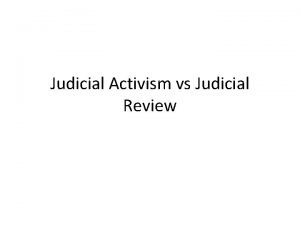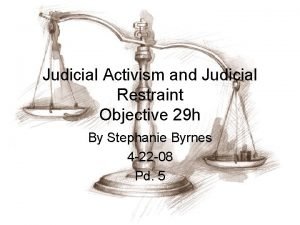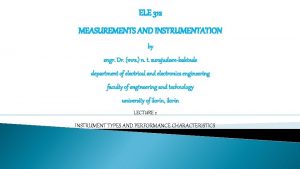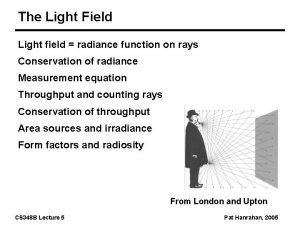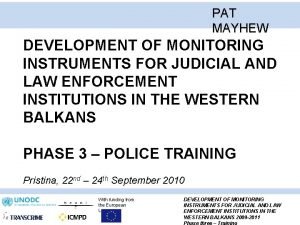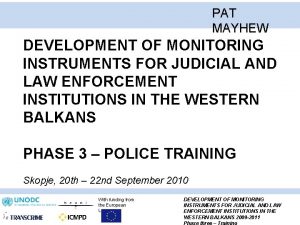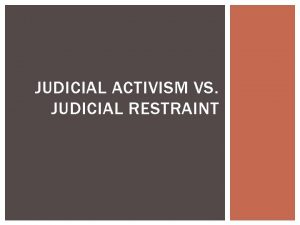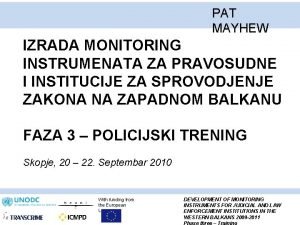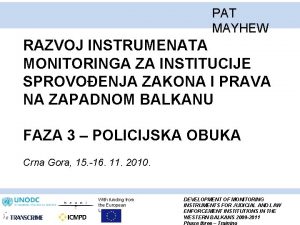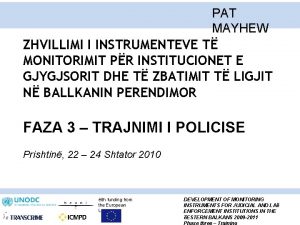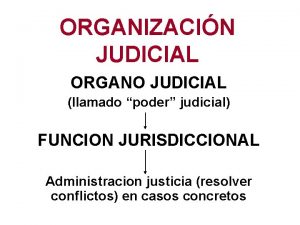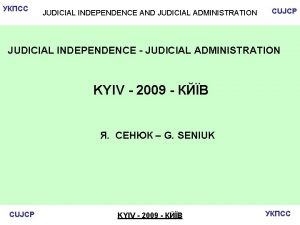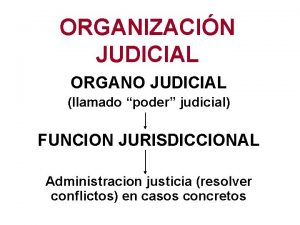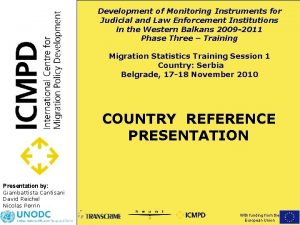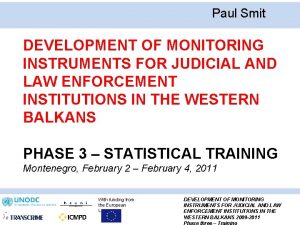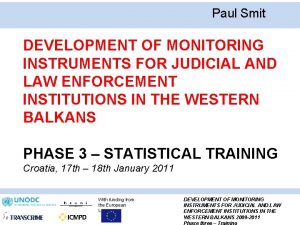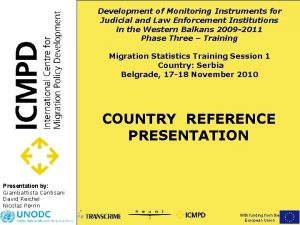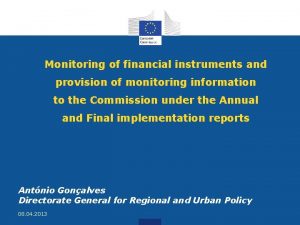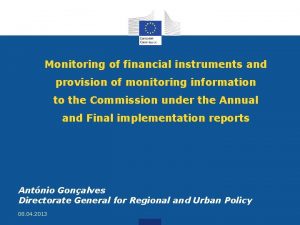PAT MAYHEW DEVELOPMENT OF MONITORING INSTRUMENTS FOR JUDICIAL


















































































- Slides: 82

PAT MAYHEW DEVELOPMENT OF MONITORING INSTRUMENTS FOR JUDICIAL AND LAW ENFORCEMENT INSTITUTIONS IN THE WESTERN BALKANS PHASE 3 – POLICE TRAINING Montenegro, 15 th – 16 th November 2010 With funding from the European Union DEVELOPMENT OF MONITORING INSTRUMENTS FOR JUDICIAL AND LAW ENFORCEMENT INSTITUTIONS IN THE WESTERN BALKANS 2009 -2011

SESSION 1 WELCOME & INTRODUCTION • Introductions • Where this training fits into the CARDS Project • How the sessions are organised

MY BACKGROUND • Retired freelance consultant • Previously Director of Crime and Justice Research Centre, Victoria University of Wellington, New Zealand • Consultant Criminologist, Autralian Institute of Criminology • Research Fellow, National Institute of Justice, USA • Most of career – UK Home Office Research, Development and Statistics Directorate § Managed and did research § Ran the British Crime Survey § Responsible for statistics on police-recorded crime § And other police figures - e. g. detections, arrests, police manpower § International comparative work

WHAT I WOULD LIKE TO ACHIEVE IN THE TRAINING • To understand the skills and needs of participants • To share my 30+ years experience of crime and justice statistics • To prepare for the next CARDS visit For anyone who would like to keep in contact… mayhew 3@btinternet. com

INTRODUCTIONS FROM PARTICIPANTS • Name, organisation, position • What you would like to achieve from the training • Any other useful information • Any comments on the proposed agenda

THE CARDS PROJECT • Objective: to strengthen justice and Home Affairs statistics in Western Balkans – To improve response to crime and corruption by bringing national statistics towards compliance with international standards and EU acquis • This CARDS Project funded by the EU under the CARDS programme with additional funds from Germany • Started in 2009, ends in 2011 • Three phases 7 countries / territories Albania, Bosnia & Herzegovina, Croatia, FYROM, Kosovo (under UNSCR 1244), Montenegro, Serbia

THE THREE PHASES: PHASE 1 (RESEARCH) • Setting out relevant international standards • Getting picture of strengths & weaknesses of data collection systems • Identifying gaps and needs of statistical systems It involved: Ø Desktop research Ø 7 research missions Main output: Ø Technical Assessment Reports for 7 countries / territories

PHASE 2 (GUIDELINES) • To identify common data collection challenges • To discuss and adopt specific draft programme guidelines • To agree a set of regional indicators • To prioritise training needs and adopt outlines of training programmes It involved: Ø Preparation of draft Programme Guidelines Ø Feedback from project countries / territories Ø Discussion and adoption at First Regional Workshop Main output: Ø Programme Guidelines adopted

PHASE 3 (TRAINING) – CURRENT STAGE • To design and deliver targeted training activities • To improve national capacities to record and report crimerelated statistics in line with international standards • To identify areas for further work and improvements It involves: Ø Training carried out by international experts together with national focal points and national counterparts Ø Training delivered to police, prosecution, courts, and institutions in areas of migration / asylum / visa

FIRST REGIONAL WORKSHOP (SKOPJE, MAY 2010) Goals • To present the technical assessment reports • To identify common data collection challenges • To adopt specific draft guidelines • To prioritise training needs • To adopt outlines of the training program • To agree on a set of regional indicators

CONCLUSIONS: SOME CHALLENGES FOR CCJ STATISTICAL SYSTEMS IN WESTERN BALKANS Those relevant to the police • Need better computerised systems to record data • Defining clear written counting rules to record crime incidents • Training all responsible staff with regard to implementation • Enhancing statistical analysis of the data collected • Improving public dissemination of the data collected

RECOMMENDATIONS FROM THE PROGRAMME GUIDELINES Recommendation Session #2 3 More information on offenders and victims # 4, 10, 29 -31 Better collection of information to suit statistical analysis and international standards and requirements 2, 3, 4, 5 # 7, 8 Counting rules for offences and suspects 3 #9 More information in published outputs 5 # 47 A possible victimisation survey 6

SESSION 2 VALID DATA AND INTERNATIONAL REPORTS OF POLICE DATA • The need for valid data and common standards • Three main international compilations of police figures

THE NEED FOR VALID POLICE STATISTICS • Collecting police statistics is expensive The money is wasted unless the figures are • valid • informative • properly analysed • Good police statistics Ø Allow the police to account for themselves to Parliament, the public and the media – showing what the police are doing Ø Enable the police to see what is happening with crime in their own country - you need to know ‘the facts’ Ø Show each area is doing

THE NEED FOR VALID POLICE STATISTICS (2) BUT good police statistics • Need to be given to managers Ø In a routine manner Ø In a way managers can understand • Need to be comparable within your own jurisdiction Ø across different areas Ø and over time Ø ideally, also need to be comparable with other jurisdictions

IMPORTANCE OF INTERNATIONAL COMPARATIVE DATA • Shows governments where they need to concentrate efforts • Can show local populations where they are doing well, and not so well • Can show where statistics infrastructure needs development (including publication)

ROLES PLAYED BY INTERNATIONAL GROUPS The main roles are: 1. Giving guidelines for collecting criminal justice statistics Ø Especially common standards 2. Giving training in the presentation and use of the statistics 3. Organising the collection of the statistics § From appropriate contact(s) in different countries § Which are then collated by a central authority 4. Publishing comparative statistics on various aspects of crime and justice

COMMON STANDARDS FOR POLICE STATISTICS • Work developing fast within the UN and the EU Ø Guidance manuals from the UN and EU (massive!) • But there are considerable difficulties in reaching comparability because of: Ø Different legal frameworks and definitions of offences Ø Different policing and prosecutorial arrangements Ø Differing capacities in criminal justice agencies Ø Different operational requirements that the statistics serve Ø Different counting rules (Session 3)

INTERNATIONAL REPORTS • Not very long-standing • All come with substantial caveats • World Health Organisation – covers violence (probably least comparable) Three main ones are: 1. United Nations Survey on Crime Trends and the Operation of the Criminal Justice System (UN – CTS) 2. European Sourcebook 3. Eurostat: Statistics in Focus – Crime and Criminal Justice

UNITED NATIONS • Latest edition 2010 (covering data from 1996 – 2006) • Data available • Montenegro has provided data but it may not be consistent with UN definitions • Covers more than police-recorded crime - e. g. , CJS personnel and prisoner numbers • Data requirements have been simplified over time http: //www. unodc. org/documents/data-and-analysis/Crimestatistics/International_Statistics_on_Crime_and_Justice. pdf

EUROPEAN SOURCEBOOK • Latest edition 2010 • About three previous editions • Data available • Montenegro has not provided data • Much work done on improving and documenting comparability http: //www. europeansourcebook. org/ob 285_full. pdf

EUROSTAT • Latest edition 2009 • Modelled on Sourcebook • Limited commentary, but good notes • Seven crime types – – – – • Total crime Homicide Violent crime Robbery Domestic burglary Theft of motor vehicle Drug trafficking Montenegro has provided data except for burglary, though definitions may not match http: //epp. eurostat. ec. europa. eu/cache/ITY_OFFPUB/KS-SF-09 -036/EN/KS-SF-09 -036 EN. PDF

SESSION 3 PARTICULAR ISSUES FROM THE RECOMMENDATIONS • Present consistency in recording crime data in Montenegro • Are there any written rules? Ø Considerations for written rules Ø Resource and training implications • Particular information on supects and victims

PRESENT CONSISTENCY OF CRIME RECORDING IN MONTENEGRO DISCUSSION INFORMATION FROM TRAINEES

COUNTING RULES IN POLICE STATISTICS Written counting rules to regulate the way in which data are recorded for police statistics is recommended. There is some ‘best practice’ guidance What we know is that 1. Some countries have written rules; some do not • In the WB, only Croatia, Serbia and FYROM have written rules 2. There are NO CONSISTENT counting rules across the Western Balkans, or across other countries

WHAT ARE THE MAIN COUNTING RULES? 1. When data are recorded for crime statistics a. Input statistics - data are included when crime incident is reported to police b. Intermediate statistics - some point between input and the output c. Output statistics - when police have completed the investigation • The application of the principal offence rule • The recording of multiple offences • The recording of offences committed by more than one person

WHEN ARE DATA COLLECTED When are data collected for recorded statistics? Albania Bosnia-Herzegovina Croatia Output Some places input; some places intermediate Output Kosovo under UNSCR 1244 Intermediate Montenegro Intermediate Serbia TFYR of Macedonia Output Intermediate The main thing is to know is that if there are input statistics, the crime count is higher

When data are recorded across European countries - 1999 -2007 Source: European Sourcebook and CARDS’ TARs European countries: The majority of European countries has input statistics Nine out of thirtysix countries use output statistics Twelve record intermediate statistics Western Balkans: the majority of WBs presents intermediate statistics, Albania,

THE PRINCIPLE OFFENCE RULE (POR) International guidelines suggest it may be appropriate to apply a POR when counting and reporting offences Written counting rules should say whether a POR rule is applied or not • In the Western Balkans, only Albania applies a POR • In other Western countries, about half apply a POR, and half do not The main thing is to know is that if there is no POR, the crime count is higher Ideally, the POR should be consistent across agencies – police, prosecutors, courts • BUT changing to a POR will reduce the crime count, and cause a ‘break’ in the crime statistics series

THE PRINCIPLE OFFENCE RULE - EXAMPLE Assault Criminal damage Offences POR No POR 1 2

Application of the Principal Offence Rule - 1999 -2007 Source: European Sourcebook and CARDS’ TARs European countries: About half apply a POR, and half do not Western Balkans: only Albania applies the POR.

MULTIPLE OFFENCES What happens when a victim reports more than one offence at the same time? For example, different incidents of domestic violence. . . • In all the Western Balkans, the rules are that all offences are counted, with the exception of Albania The important thing is for the rules to be understood and consistently applied

Recording of multiple offences (serial offending) - 1999 -2007 Source: European Sourcebook and CARDS’ TARs European countries: the majority records multiple offences as two or more offences 33 Western Balkans situation: the majority of WBs records multiple offences as two ore more offences. Only Albania records them as one offence.

MULTIPLE OFFENDERS / SUSPECTS If there is more than one offender involved in an offence, six of the Western Balkans countries count one offence In Kosovo under UNSCR 1244, the number of offences = the number of offenders The main thing to know is that if serial offending is recorded as two or more offences, the crime count is higher But In terms of suspects, it is reasonable to count two

Recording of multiple offenders (suspects) - 1999 -2007 Source: European Sourcebook and CARDS’ TARs European countries: Most count only one offence when more than one person commit it. Western Balkans situation: All the WBs record one offence except Kosovo under UNSCR 1244 who records them as two or more offences.

OTHER COUNTING RULES ISSUES DOC. N. 6: HOME OFFICE COUNTING RULES IS USEFUL Some issues are: Ø Whether to record a crime, misdemeanour, or incident at all? Ø ‘No crime-ing’ after recording Ø ‘Evidenced-based’ recording or ‘prima facie’ recording (i. e. taking the victim’s word) Ø Crimes per victim or per episode? – e. g. shoplifting in several shops Ø Classification and re-classification WHAT IS CURRENTLY MOST OFTEN DONE MAY BE THE BEST STARTING POINT FORMALISING WRITTEN RULES

RESOURCE AND TRAINING IMPLICATIONS Ø Who would take the lead in formulating written rules? Ø How would prosecutors be involved? Ø What learning opportunities would personnel be given? Ø What testing mechanisms would be put in place? Ø How would the written rules be revised? DISCUSSION

VICTIM OFFENDER RELATIONSHIPS • Victim-offender relationships Ø Relevant to Recommendations # 2 Ø Relevant to Pilot Data Collection Exercise

VICTIM-OFFENDER RELATIONSHIPS See Handout # 2 INTERNATIONAL CRIME VICTIMISATION SURVEY 1 Spouse, partner (at the time) 2 Ex-spouse, ex-partner (at the time) 3 Boyfriend (at the time) 4 Ex-boyfriend (at the time) 5 Relative 6 Close friend 7 Someone he/she works/worked with 8 None of these 9 Refuses to say

VICTIM-OFFENDER RELATIONSHIPS See Handout # 2 UN MANUAL FOR THE DEVELOPMENT OF A SYSTEM OF CRRIMINAL JUSTICE STATISTICS (pp. 55 AND 60) Spouse Ex-spouse Parent Child Other family Friend Business relation Acquaintance Stranger Other Issue of ‘partners’ Issue of step-parents What is a ‘child’ How extended is the ‘family’ Boy-friend / girl-friend? Seen before but don’t know? The issue is whether known or not

VICTIM-OFFENDER RELATIONSHIPS The primary interest is in: • People known to each other >>> not known to each other Ø Important for ‘stranger violence’ • People who are (or were) partners (‘partner violence’) Ø Violence by ex-partners seen as important as violence by current partners • People who are in a domestic relationship ranging wider than partners (‘domestic violence’) There are several possible classification

VICTIM-OFFENDER RELATIONSHIPS – OTHER ISSUES • Relationship can only be recorded if there is a relationship offences • Relationships when there is more than one victim? • Relationships when there is more than one offender? • Whose account of the relationship does one take – the offender or the victim’s? DISCUSSION

ETHNICITY AND CITIZENSHIP • Ethnicity and citizenship Ø Recommendation # 2 Ø Relevant to Pilot Data Collection Exercise • Recommendation #2 asks for citizenship to be collected for suspects and victims • Pilot Data Collection Exercise asks for citizenship and ethnicity to be collected for suspects and victims • Citizenship is a data field in the police recording form for suspects? Ø How well is this completed? • Would there be problems with recording ethnicity? DISCUSSION

RECIDIVISM OF OFFENDERS (1) • Recidivism of offenders Ø Relevant to Pilot Data Collection Exercise See Handout # 4 (Pilot Data Collection Exercise) • It is unusual to report on offender recidivism in publications on ‘crime statistics’ Ø More often reported in relation to prosecution or courts statistics • There are some problems Ø What is a recidivist? What counts? • Anyone previously arrested? • Only those previously sanctioned? But what about police warnings and cautions?

RECIDIVISM OF OFFENDERS (2) See Handout # 4 • The Pilot Data Collection Exercise seems problematic Ø Asks for “recidivists of the same offence”. What is the same offence? Ø What if the suspect is recidivist of the same offence AND another offence? The totals won’t add up. DISCUSSION

SESSION 4 THE PILOT DATA COLLECTION EXERCISE • Suggested Regional Crime Indicators • The Pilot Data Collection Exercise

SUGGESTED REGIONAL CRIME INDICATORS See Handout # 3 The following offence types are considered core crimes to be covered in 12 th UN Survey by the end of 2010: Intentional Homicide Violent Crime Assault Sexual Violence Rape Robbery Offences in red are NOT being covered in the Pilot Data Collection Exercise Property Crime Theft Motor Vehicle Theft Burglary Domestic Burglary/Housebreaking Drug Possession/Use Drug Trafficking Kidnapping for Ransom

OFFENCES FOR THE PILOT DATA COLLECTION EXERCISE Which of these is going to cause problems? How far are the definitions in footnotes in Handout # 4 the same? Data Collection Exercise All offences Completed Intentional Homicide Violent crime Assault Sexual violence Rape Robbery Drug Trafficking Drug use /possession Migrants smuggling Trafficking in persons Total corruption offences Passive bribery

COMPLETED INTENTIONAL HOMICIDE The intentional killing of a person INCLUDING – Murder – Manslaughter – Euthanasia – Infanticide EXCLUDING – Attempted homicide – Causing death by dangerous driving – Abortion – help with suicide

VIOLENCE AGAINST THE PERSON INCLUDES EXCLUDES Assault • Physical attack resulting • Indecent sexual assault in serious bodily injury • Threats and slapping/punching • Assault leading to death Rape • Sexual intercourse without valid consent • Offences against children Other sexual • Offences against violence children Robbery • Stealing with force or threat of force • Muggings • Pick-pocketing • Extortion • Blackmail

DRUG TRAFFICKING Illegal drug operations which are not solely in connection with personal use INCLUDES – Possession – Cultivation – Production – Supplying – Transportation – Importing – Exporting – Financing etc.

OTHER INFORMATION FOR THE PILOT DATA COLLECTION EXERCISE (1) See Handout # 4 No. of CRIMES recorded by the police Recorded by the police (some crimes are not reported by victims) By offence type No. of persons recorded by the police as SUSPECTS First stage of ‘attrition’ calculation. In the current system = ‘suspects’ By offence type By age By sex By citizenship By ethnicity Not currently collected in Montenegro By whether recidivist or not Feasible? Not currently collected?

OTHER INFORMATION FOR THE PILOT DATA COLLECTION EXERCISE (2) Currently, Montenegro collects only name and address of the victim See Handout # 4 No. of VICTIMS recorded Issue of counting number of victims By offence type By age By sex By citizenship By ethnicity Offender-Victim Relationship By offence type Problematic for some crimes? Not currently collected?

CRIME DATA COLLECTION FORM (1) UN Manual (page 55) shows a suggested form, although it does not include all the items wanted for the Pilot Data Collection Exercise A summary is below – see also Doc N. 9 (page 55) Incident information Name of force Location Incident number Type of offence reported Sate of incident Date reported Incident clearance status Date cleared No. offenders No. of victims Target of incident Weapon present Location of incident Property stolen

CRIME DATA COLLECTION FORM (2) Based on UN Manual (page 55) – see Doc N. 9 Victim information No. * Name Age Sex Citizenship Ethnicity Level of injury Relation to victim Offender information No. * Name Age Sex Citizenship Ethnicity Recidivism Charges There may be more than one offender and more than one victim

SESSION 5 PUBLICATION OF RESULTS, ANALYSIS AND INTERPRETATION • Two examples of national reports • Overview of the current reports in Montenegro • Type and amount of analysis and interpretation

NATIONAL REPORTS • Massive variety of styles • Usually annual • Sometimes with other criminal justice system information; sometimes not • Sometimes with special topics; sometimes not • USA – ‘Index’ crimes only • Nearly all publically available • Now also usually available on the web • Data sometimes downloadable

ENGLAND & WALES • Publication has changed over time • Now covers British Crime Survey (BCS) and police figures • Produce additional reports - e. g. , homicide • Also quarterly bulletins • Publication tightly controlled by Office of National Statistics rules

ENGLAND & WALES (2) Latest publication covers: Ø Extent of and trends in crime Ø Violent and sexual crimes Ø Acquisitive and other property crime Ø Publications perceptions Ø Detection of crime Ø Geographic patterns of crime Most chapters draw on police figures and British Crime Survey Discontinuance in police figures Ø Major changes in offence coverage in 1998 § e. g. , minor assaults Ø Also changes in police recording practices § e. g. , counting by victims

NEW ZEALAND GOOD POINTS • Straightforward • Show detection (resolution) figures • Monthly online figures BAD POINTS • Both fiscal and calendar year publications – too much • Little commentary (need to read Police Annual Report as well) • Nothing about victims • Nothing about offenders

NEW ZEALAND (2) • Review of statistics in 2009 (last review in 1982) – • e. g. recommendation to record victim-offender relationship Another discontinuance in the figures Ø Major change in computer systems § New system meant fewer offences were ‘lost’ Ø New police recording rules § Bought some area more into line with the areas with the most ‘generous’ recording

CURRENT REPORTS IN MONTENEGRO • What are they? • My understanding Published In English Monthly Report of the Work of the Criminal Police Annual Report of the Police DISCUSSION ? No? Online ?

THE CURRENT PUBLICATIONS: GOOD AND BAD How are the current ‘publications’ received? Ø What tables are most needed, used and liked? Ø What are the main problems in compiling them? Ø How could these problems be resolved? DISCUSSION

ENGLISH PUBLICATION? USER REQUIREMENTS? How feasible is publication in English? Do current publications matching different user requirements? How much information is already there to service the Regional Indicators and the Pilot Data Collection Exercise? DISCUSSION

ANALYSIS Doc N. 9: UN Manual – Chapter VI, Annex B & F – some guidelines Analysis: some principles • People like some degree of consistency • Longer-term figures are useful (not just this year / last year) • Graphical material is good, but keep it simple • Per capita rates are useful for: Ø different areas (crimes / population) Ø different population groups (offenders x ethnicity / population x ethnicity)

PER CAPITA RATES (1) District 1 District 2 No. offences 5, 000 3, 000 Population 100, 000 40, 000 Rate per 1, 000 pop. 50 75 < most offences < smaller population < Highest rate

PER CAPITA RATES (2) Citizenship 1 Citizenship 2 No. offenders 1, 000 500 Population 50, 000 10, 000 Rate per 1, 000 pop. 20 50 < most offenders < smaller group < Highest rate

INTERPRETATION (1) Analysis should normally be limited to • presentation and technical interpretation of the data. While users often want interpretive analysis of. . policy implications …a bureau of criminal justice statistics may • jeopardise its credibility and perceived objectivity by performing this type of analysis. …. Policy analysis and data interpretation may be more appropriately done by subject-matter specialists under the guidance of statistical experts. UN Manual, page 33

INTERPRETATION (2) • Most official reports just present the facts Ø Avoiding – e. g. – “large increase” / “small increase” • But ‘odd’ results may need explaining Ø they are often due to technical factors • Important to explain discontinuances in the data Ø It may be an analysis task to ‘splice’ the data, or rework it

SESSION 6 VICTIMISATION SURVEYS • The purposes of victimisation surveys • Strengths and weaknesses • Three international comparative exercises Ø International Crime Victimisation Survey (ICVS) Ø ICVS-11 Ø Eurostat survey in 2013 Ø Western Balkans Corruption Survey

VICTIMISATION SURVEYS (1) • Developed since 1970 s (USA, Netherlands, Scandinavia) • Many countries now have their own ‘bespoke’ surveys Ø which have run for many years Ø providing an independent measure of trends in crime • These bespoke surveys are not very comparable e. g. , Differences in offence coverage Counting rules! • Some international surveys (later)

VICTIMISATION SURVEYS (2) • Focus on individuals and their direct experience of crime Ø Whether or nor reported to the police Ø Thus providing an independent measure of crime • Good for describing the nature of everyday experience of victimisation • Can show which types of people are most at risk (by collecting sociodemographic information • Use sample survey methodology – mainly to get representative samples • Household surveys most common, but there also Ø Surveys of businesses • Generally take up other crime-related topics – e. g. , fear of crime, security precautions, attitudes to the police

VICTIMISATION SURVEYS (3) • Sometimes focus on particular groups e. g. , women, ethnic minorities • Sometimes focus on particular types of crime e. g. , domestic violence, sexual victimisation • Usually measure victimisation over the last year (but sometimes longer) • Many countries have their own ‘bespoke’ surveys Ø Which have run for many years – providing independent measure of trends in crime • These bespoke surveys are not very comparable e. g. , Differences in offence coverage Counting rules!

VICTIMISATION SURVEYS (LIMITATIONS) • Can’t cover all crimes Ø murder (obviously) Ø Fraud Ø victimisation of children difficult • Non-response can be high Ø Are non-responders different? • Do respondents remember everything? Minor offences likely to be forgotten • Do respondents tell interviewers everything? (Domestic violence) • Sampling error Ø Problematic for more uncommon crimes (e. g. , robbery)

VICTIMISATION SURVEYS (METHODS) • Face-to-face interviews were ‘gold standard’ – but expensive • Computer technology - made a big difference Ø CAPI – Computer Assisted Personal Interviewing Ø CATI – Computer Assisted Telephone Interviewing § Cheap, but limits interview length § Increasing mobile phone ownership posing a problem Ø CASI – Computer Assisted Self Interviewing § Good for sensitive subjects • Postal questionnaires uncommon Ø Cheap but poor response • Internet surveys in development – Computer Assister Web Interviewing (CAWI) Ø But will need lots of testing

INTERNATIONAL VICTIMISATION SURVEYS • Set up because independent surveys not comparable Ø Meant to use identical questionnaires Ø And same analysis methods • A few international business surveys • Some international surveys on violence against women Ø but some lack of comparability – e. g. World Health Organisation

THE MAIN ONES International Crime Victimisation Survey (ICVS) Five sweeps - 1989, 1992, 1996, 2000, 2004/5 Tirana (Albania) ‘ 96; Zagreb (Croatia) ‘ 96, 2000; Skopje ’ 86 Belgrade (Yugosl. ) ‘ 96 2004/5 ICVS – two different threads EU-ICVS 15 member states ICVS outside EU 15 countries All told, 30 countries + 33 city surveys None of the Western Balkan countries ICVS-II – 2 rounds Mainly testing (including CAWI) 2008 4 countries 2010 6 countries

SURVEYS TO BE COMPLETED Eurostat 2013 All member states Questionnaire piloted tested in 17 countries Questionnaire now revised (see Handout # 5) but not agreed UNODC CORRUPTION SURVEYS IN WESTERN BALKANS Has short victimisation survey module (see Handout # 7) Mainly National Statistical Offices A private contractor in Montenegro (PRISM) has carried out the fieldwork but no results as yet

THE QUESTIONNAIRES & METHODOLOGY • Some similarities in the questionnaires, but even small changes make a difference • Small changes in methodology can also upset comparability. • Western Balkans victimisation results (in corruption survey) may not be comparable with other surveys Ø Because of smaller number of prompts Ø Violent victimisation especially problematic • Eurostat 2013 survey will have different prompts for violence Handout # 5 = 2013 Eurostat questionnaire Handout # 6 = ICVS-II questionnaire Handout # 7 = W. Balkans Corruption Survey – victimisation questions

SESSION 7 PLANS ROUND–UP AND FUTURE Summary of previous sessions Does anything need more attention for future training? Future plans – short and long term goals

SHORT-TERM AND LONG-TERM GOALS What are the goals? Which are longer-term? Which are shorter-term? Decisions Who takes them forward? What are the deadlines? Are resources needed?

PAT MAYHEW DEVELOPMENT OF MONITORING INSTRUMENTS FOR JUDICIAL AND LAW ENFORCEMENT INSTITUTIONS IN THE WESTERN BALKANS PHASE 3 – POLICE TRAINING Montenegro, 15 th – 16 th November 2010 With funding from the European Union DEVELOPMENT OF MONITORING INSTRUMENTS FOR JUDICIAL AND LAW ENFORCEMENT INSTITUTIONS IN THE WESTERN BALKANS 2009 -2011
 Michael mayhew rome ny
Michael mayhew rome ny Pat pat seguimiento
Pat pat seguimiento Judicial activism vs judicial restraint
Judicial activism vs judicial restraint Judicial restraint vs judicial activism
Judicial restraint vs judicial activism Judicial restraint vs judicial activism
Judicial restraint vs judicial activism Judicial activism vs judicial restraint
Judicial activism vs judicial restraint Judicial restraint
Judicial restraint Examples of passive instruments
Examples of passive instruments Pressure measuring devices
Pressure measuring devices Fspos
Fspos Typiska drag för en novell
Typiska drag för en novell Nationell inriktning för artificiell intelligens
Nationell inriktning för artificiell intelligens Vad står k.r.å.k.a.n för
Vad står k.r.å.k.a.n för Shingelfrisyren
Shingelfrisyren En lathund för arbete med kontinuitetshantering
En lathund för arbete med kontinuitetshantering Kassaregister ideell förening
Kassaregister ideell förening Personlig tidbok fylla i
Personlig tidbok fylla i A gastrica
A gastrica Vad är densitet
Vad är densitet Datorkunskap för nybörjare
Datorkunskap för nybörjare Boverket ka
Boverket ka Debattartikel struktur
Debattartikel struktur Delegerande ledarstil
Delegerande ledarstil Nyckelkompetenser för livslångt lärande
Nyckelkompetenser för livslångt lärande Påbyggnader för flakfordon
Påbyggnader för flakfordon Vätsketryck formel
Vätsketryck formel Offentlig förvaltning
Offentlig förvaltning I gullregnens månad
I gullregnens månad Presentera för publik crossboss
Presentera för publik crossboss Teckenspråk minoritetsspråk argument
Teckenspråk minoritetsspråk argument Kanaans land
Kanaans land Klassificeringsstruktur för kommunala verksamheter
Klassificeringsstruktur för kommunala verksamheter Fimbrietratt
Fimbrietratt Claes martinsson
Claes martinsson Centrum för kunskap och säkerhet
Centrum för kunskap och säkerhet Programskede byggprocessen
Programskede byggprocessen Mat för unga idrottare
Mat för unga idrottare Verktyg för automatisering av utbetalningar
Verktyg för automatisering av utbetalningar Rutin för avvikelsehantering
Rutin för avvikelsehantering Smärtskolan kunskap för livet
Smärtskolan kunskap för livet Ministerstyre för och nackdelar
Ministerstyre för och nackdelar Tack för att ni har lyssnat
Tack för att ni har lyssnat Referatmarkering
Referatmarkering Redogör för vad psykologi är
Redogör för vad psykologi är Matematisk modellering eksempel
Matematisk modellering eksempel Atmosfr
Atmosfr Borra hål för knoppar
Borra hål för knoppar Vilken grundregel finns det för tronföljden i sverige?
Vilken grundregel finns det för tronföljden i sverige? R formel
R formel Tack för att ni har lyssnat
Tack för att ni har lyssnat Steg för steg rita
Steg för steg rita Verksamhetsanalys exempel
Verksamhetsanalys exempel Tobinskatten för och nackdelar
Tobinskatten för och nackdelar Toppslätskivling dos
Toppslätskivling dos Datumr
Datumr Egg för emanuel
Egg för emanuel Elektronik för barn
Elektronik för barn Mantel för kvinnor i antikens rom
Mantel för kvinnor i antikens rom Strategi för svensk viltförvaltning
Strategi för svensk viltförvaltning Kung som dog 1611
Kung som dog 1611 Humanitr
Humanitr Ro i rom pax
Ro i rom pax Tack för att ni lyssnade
Tack för att ni lyssnade Vilka tal pekar pilarna på
Vilka tal pekar pilarna på Rim texter
Rim texter Inköpsprocessen steg för steg
Inköpsprocessen steg för steg Rådet för byggkompetens
Rådet för byggkompetens Ledarskapsteorier
Ledarskapsteorier Slyngexcision
Slyngexcision Myndigheten för delaktighet
Myndigheten för delaktighet Frgar
Frgar Sju principer för tillitsbaserad styrning
Sju principer för tillitsbaserad styrning Läkarutlåtande för livränta
Läkarutlåtande för livränta Karttecken tät skog
Karttecken tät skog Lek med geometriska former
Lek med geometriska former Vishnuismen
Vishnuismen Mitos steg
Mitos steg Bris för vuxna
Bris för vuxna Bamse för de yngsta
Bamse för de yngsta Complete the text. write one word in each space
Complete the text. write one word in each space Pat oliphant cartoon archive
Pat oliphant cartoon archive Study of speech sound
Study of speech sound Pat coso
Pat coso
